
Station Name: STANSFIELD HALL
[Source: Alan Young]
| Date opened: |
8.1869: first appearance (without trains) in Bradshaw; trains first shown calling in 6.1871 |
| Location: |
Stansfield Road / Railway Street, Todmorden; immediately north-west of the recently reinstated Stansfield Hall Junction; railway still in use |
| Company on opening: |
Lancashire & Yorkshire Railway |
| Date closed to passengers: |
31.7.1944 (service ‘suspended’) |
| Date closed completely: |
10.1949 (service not to be reinstated) |
| Company on closing: |
London, Midland & Scottish Railway |
| Present state: |
Demolished |
| County: |
West Riding of Yorkshire |
| OS Grid Ref: |
SD913262 |
| Date of visit: |
October 1977 and July 2016 |
Notes: The west-facing junction onto the Copy Pit route (officially the ‘Burnley Branch’) at Todmorden station was very inconvenient for traffic to and from Yorkshire which included a large number of long coal trains from the Yorkshire coalfields and long Blackpool specials in summer. Congestion was caused as they had to reverse across the main Calder Valley line to enter or leave the branch. A decision appears to have been taken in spring 1861 to construct a spur from the main line at Hall Royd, a short distance east of Todmorden station, to a junction with the Copy Pit route in the White Platts area of Todmorden. Initially known as White Platts Junction it was renamed Stansfield Hall Junction in about 1895.
Stansfield Hall station was provided as a calling point for trains travelling between Burnley and Halifax, and vice versa, which did not pass through Todmorden station. Some Todmorden historians have suggested that the station was initially opened for the convenience of Joshua Fielden of nearby Stansfield Hall when he became an MP in November 1868. It was situated about a quarter of a mile from Todmorden town centre. At the time prior to 1888 Todmorden’s urban area was divided between the West Riding of Yorkshire and Lancashire; Stansfield Hall was within the West Riding. The neighbouring stations of Cornholme and Portsmouth were in Lancashire until the boundary revision of 1888 placed them administratively in the West Riding.
The early history of the station is difficult to unravel as it appears not to have enjoyed a formal opening, and sources differ as to which month and year this was, and for many years the name seems to have been fluid – either Stansfield Hall or Todmorden White Platts.
 David Taylor, a historian specialising in the Upper Calder Valley, has found the earliest mention of a stopping place at White Platts Junction (today known as Stansfield Hall Junction) in the December 1868 timetable for Todmorden – Burnley services which shows an additional daily train each way for first and second class passengers stopping at ‘Todmorden White Platts’, although not at any of the intermediate stations on the Copy Pit route, presumably a Yorkshire service. However it was some months later that the station made its first appearance in Bradshaw; this wasin August 1869, and with the name of Stansfield Hall, but no trains were shown to call. It was not until June 1871 that Bradshaw indicated that trains stopped here. David Taylor, a historian specialising in the Upper Calder Valley, has found the earliest mention of a stopping place at White Platts Junction (today known as Stansfield Hall Junction) in the December 1868 timetable for Todmorden – Burnley services which shows an additional daily train each way for first and second class passengers stopping at ‘Todmorden White Platts’, although not at any of the intermediate stations on the Copy Pit route, presumably a Yorkshire service. However it was some months later that the station made its first appearance in Bradshaw; this wasin August 1869, and with the name of Stansfield Hall, but no trains were shown to call. It was not until June 1871 that Bradshaw indicated that trains stopped here.
Taylor’s research has unearthed further details of the station’s early years. In August 1870 a timetable in Todmorden & District News (5 August) shows that Bradford – Blackpool Sunday excursions are scheduled to stop at ‘Stansfield Hall’ but the timetable for the daily Todmorden-Burnley service confusingly still refers to ‘White Platts’. A decade later the timetable in the same newspaper on 16 July 1880 for the summer Blackpool service also refers to ‘White Platts’ and not to ‘Stansfield Hall’. By 1890 the timetables all read ‘Stansfield Hall’, although the only weekday train scheduled to stop there is a daily Blackpool each way but none on Sundays, even in August. It would appear that only the Blackpool and Southport services from Yorkshire were scheduled to stop at White Platts/Stansfield Hall. It is unclear when White Platts Junction and the station were both formally renamed Stansfield Hall; perhaps the name ‘White Platts’ was an informal local name for the station which simply fell out of use?
Both the frequency of the train service and the passenger facilities at Stansfield Hall were vastly inferior to those of Todmorden station. Photographic evidence indicates that only an undistinguished timber building was provided on the down platform and it is assumed that the up platform boasted nothing better. A level crossing was originally located at the station, but this was extinguished and a footbridge was provided in its stead.
The signal box at the station was originally known as Whiteplatts Junction (Littleworth, 2003, gives Whiteplatts as a single word) and it was in use by 1873; the type of box is not known but it contained a 16-lever frame. In 1895 a Size 3 LYR box replaced it, also on the up side of the line, originally containing a 16-lever LYR frame. The new box was named Stansfield Hall, either from its opening or from 1897 – sources disagree. The frame was extended to 20 levers when the ‘new sidings’ were installed, and it was eventually extended further to 24 levers, certainly by 1944
Up trains: weekdays
August 1887 |
Destination |
No Down trains shown to call |
No destinations |
11.40am |
Todmorden |
- |
- |
12.05pm |
Sowerby Bridge |
- |
- |
3.47pm |
Bradford |
- |
- |
4.58pm |
Normanton |
- |
- |
5.41pm |
Bradford |
- |
- |
Up train: Sunday |
|
- |
- |
8.37pm |
Bradford |
- |
- |
Up trains: weekdays
July 1922 |
Destination |
Down train: weekdays |
Destination |
8.25am |
Todmorden |
9.19am |
Blackpool Central |
8.48am |
Blackpool Central |
8.29pm |
Blackburn |
12.11pm |
Bradford |
- |
- |
1.09pm |
Leeds |
- |
- |
2.38pm Wed & Sat ‡ |
Hull Riverside |
- |
- |
3.45pm |
Wakefield # |
- |
- |
No Sunday trains |
|
No Sunday trains |
|
‡ Calls to take up for Brighouse and beyond # via Cleckheaton
The train departures tabulated here indicate the infrequent and variable service. In 1887 only up trains are shown to call at unpredictable intervals, and in the LNWR table of 1922, although down trains call, they are easily outnumbered by up train departures.

Up trains: weekdays June 1943 |
Destination |
Down trains: weekdays |
Destination |
8.19am |
Todmorden |
9.24am Sat excepted |
Blackpool Central |
12.57pm Sat only |
Halifax |
9.29am Sat only |
Blackpool Central |
3.32pm |
Wakefield |
8.38pm |
Preston |
No Sunday trains |
- |
No Sunday trains |
- |
The LMS World War 2 timetable from 1943 is balanced with only two departures each weekday in each direction. Trains ceased to call the following year, but British Railways (London Midland Region) decided to close the station entirely in 1949. It is not known when the platforms were demolished but photographic evidence from early 1971 shows that they had disappeared. The signal box outlasted the station and was decommissioned on 22 October 1973 when Preston Power Signal Box took control of this section of line. By this time the tracks to Todmorden East Junction had been lifted; this link was to be reinstated as the single-track ‘Todmorden Curve’ in May 2015 to be used by Blackburn-Manchester passenger trains.
 A little under a mile west of Stansfield Hall a signal box stood east of Kitson Wood Tunnel. The Kitson Wood box, a timber LYR structure, opened in 1907. According to a contemporary LYR report it contained a 16-lever LYR frame; Littleworth notes that later sources refer to an 8-lever frame, but since at least the mid 1940s only 4 levers were in use. A source of 1947 states that the box closed in winter months and that the signal arms were removed. Kitson Wood box was closed completely on 18 June 1961 and no photographs of it have been found. A little under a mile west of Stansfield Hall a signal box stood east of Kitson Wood Tunnel. The Kitson Wood box, a timber LYR structure, opened in 1907. According to a contemporary LYR report it contained a 16-lever LYR frame; Littleworth notes that later sources refer to an 8-lever frame, but since at least the mid 1940s only 4 levers were in use. A source of 1947 states that the box closed in winter months and that the signal arms were removed. Kitson Wood box was closed completely on 18 June 1961 and no photographs of it have been found.
Tickets from Michael Stewart
Click here for a brief history of the Copy Pit line
See also Copy Pit Route Collieries
See other stations on the Copy Pit line: Burnley Manchester Road (1st site), Burnley Manchester Road (2nd), Towneley, Holme, Portsmouth (Lancs), Cornholme, Eastwood & Hebden Bridge (still open) |
The north-western end of Stansfield Hall’s low platforms, pre-1890, judging by the absence of housing on what was to become Park Road.
Photo
from John Mann collection

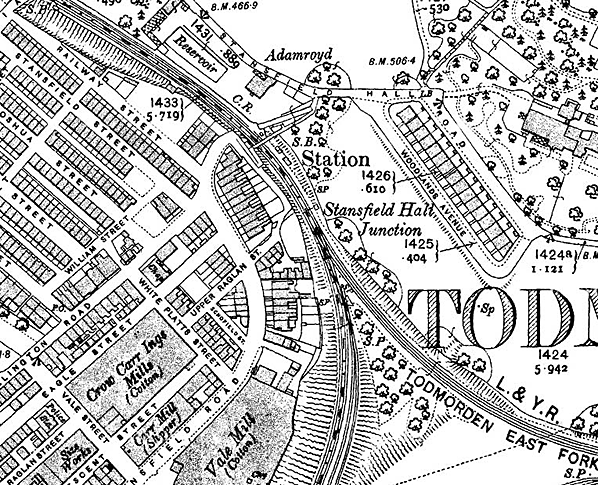 1907 1: 2,500 OS map. Todmorden station was located south-west of a triangular junction, so that trains between Burnley and Hebden Bridge could not serve it without reversing. In 1869 Stansfield Hall station was built immediately north-west of the triangular junction, about 500yd from Todmorden station, so that Burnley-Hebden Bridge trains could now serve the town. Stansfield Hall station is shown on this map, but the cartography seems less precise than we are accustomed to expect of OS maps. The two platforms are not distinct and there is no clear evidence of access to the station. Small buildings can be seen north-east of the railway on either side of the footbridge linking Stansfield Road and Stansfield Hall Road, and SB (signal box) is printed above the word ‘Station’, referring to the larger south-eastern structure. At Stansfield Hall Junction the line heading southwards joins the Manchester and Leeds line at Todmorden Junction, shortly before Todmorden station; the other line, Todmorden East Fork, joins the Manchester and Leeds at Hall Royd Junction. 1907 1: 2,500 OS map. Todmorden station was located south-west of a triangular junction, so that trains between Burnley and Hebden Bridge could not serve it without reversing. In 1869 Stansfield Hall station was built immediately north-west of the triangular junction, about 500yd from Todmorden station, so that Burnley-Hebden Bridge trains could now serve the town. Stansfield Hall station is shown on this map, but the cartography seems less precise than we are accustomed to expect of OS maps. The two platforms are not distinct and there is no clear evidence of access to the station. Small buildings can be seen north-east of the railway on either side of the footbridge linking Stansfield Road and Stansfield Hall Road, and SB (signal box) is printed above the word ‘Station’, referring to the larger south-eastern structure. At Stansfield Hall Junction the line heading southwards joins the Manchester and Leeds line at Todmorden Junction, shortly before Todmorden station; the other line, Todmorden East Fork, joins the Manchester and Leeds at Hall Royd Junction.
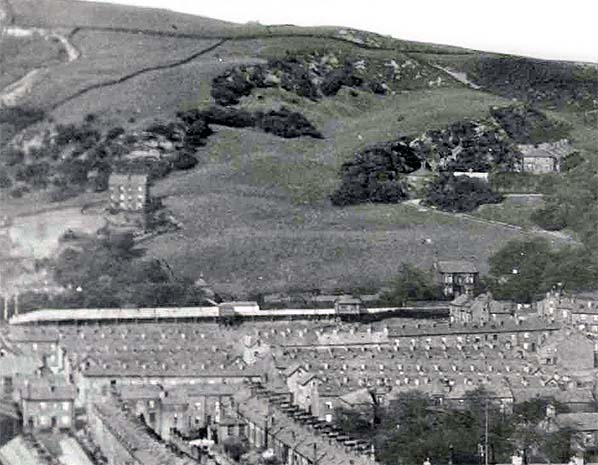 In this detail from a wider panorama of Todmorden, looking north-east, the down platform of Stansfield Hall station stretches across the picture. The lengthy platform could accommodate the large numbers of passengers and the long trains bound for Blackpool; the later photograph (below) gives some indication of the crowd that would gather for such trains. The photograph dates from Click here to see the full panorama.
Photo from Pennine Horizons Digital Archive
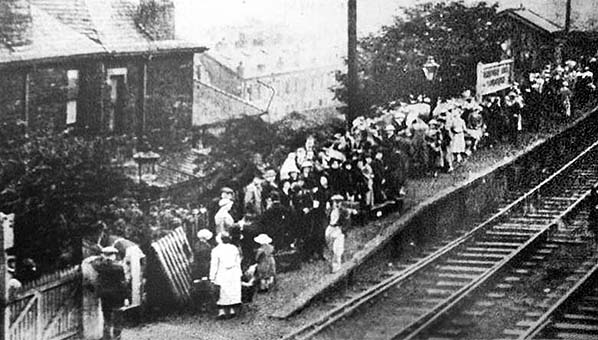
A view of the down platform of Stansfield Hall station on 17 July 1936, including the modest timber building and the ‘Stansfield Hall Todmorden’ running-in nameboard. The lanterns are probably powered by gas. The large crowd is waiting for the arrival of an excursion train bound for Blackpool.
Photo from Todmorden Advertiser
Stansfield Hall station looking north-west, shortly before or after closure (1944). The timber shed on the down platform is the only significant structure seen on the station.
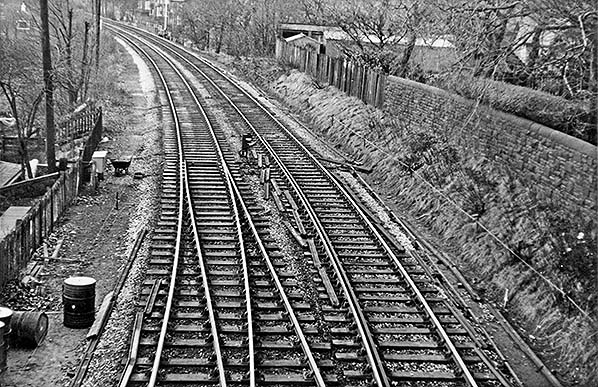
The site of Stansfield Hall station in February 1971, looking north-west.
Photo
by John Mann
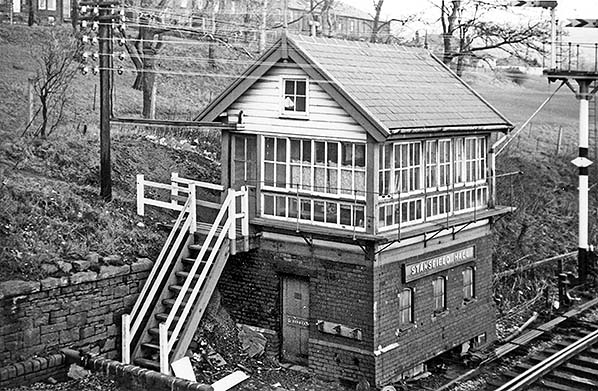
Stansfield Hall signal box photographed in February 1971. The box is a brick-based LYR Size 3 structure. It would close on 22 October 1973 when Preston Power Signal Box took over control of this section of line.
Photo
by John Mann
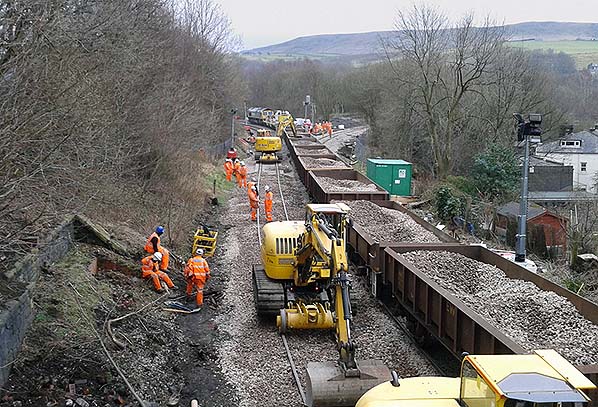
The site of Stansfield Hall station on 6 March 2014. In this view engineering work is in progress in connection with re-laying the long-lifted Todmorden Curve, so that trains can reach the Copy Pit line directly from Todmorden / Manchester. The newly re-laid curve is visible to the right of the third and fourth wagons behind the loco in this picture. The track on the right of the picture, on which the train is standing, was actually re-laid the previous night, as was the track on which the mechanical excavator is standing. The recess to the left bordered by brickwork is where Stansfield Hall signal box (seen above) used to stand and in the distance, in what is now woodland, is where the Copy Pit bankers used to stable in steam days. The loco at the front of the engineering train is 66514.
Photo
by Neil Harvey from his Flickr photostream
On 21 July 2016 the 09.18 departure from York formed by Class 158 No.158 758 is heading towards Blackpool North and approaching the site of Stansfield Hall station, of which nothing remains. The ‘Todmorden Curve’, opened in 2015 is seen to the right, enabling trains to travel directly between Burnley Manchester Road, Todmorden and Manchester Victoria/
Photo
by Alan Young
| Last
updated: Tuesday, 28-Aug-2018 14:19:24 CEST |
© 1998-2016 Disused Stations
| |

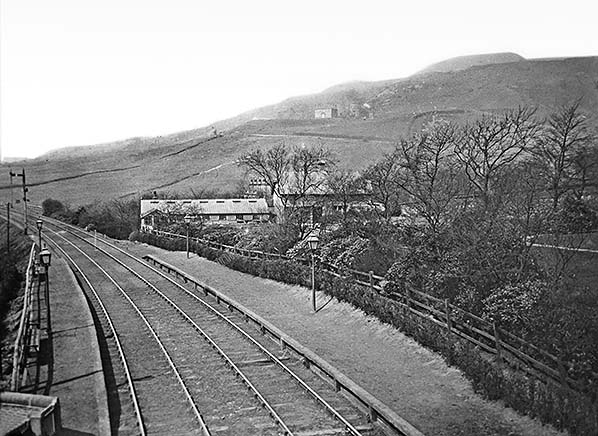

 1907 1: 2,500 OS map. Todmorden station was located south-west of a triangular junction, so that trains between Burnley and Hebden Bridge could not serve it without reversing. In 1869 Stansfield Hall station was built immediately north-west of the triangular junction, about 500yd from Todmorden station, so that Burnley-Hebden Bridge trains could now serve the town. Stansfield Hall station is shown on this map, but the cartography seems less precise than we are accustomed to expect of OS maps. The two platforms are not distinct and there is no clear evidence of access to the station. Small buildings can be seen north-east of the railway on either side of the footbridge linking Stansfield Road and Stansfield Hall Road, and SB (signal box) is printed above the word ‘Station’, referring to the larger south-eastern structure. At Stansfield Hall Junction the line heading southwards joins the Manchester and Leeds line at Todmorden Junction, shortly before Todmorden station; the other line, Todmorden East Fork, joins the Manchester and Leeds at Hall Royd Junction.
1907 1: 2,500 OS map. Todmorden station was located south-west of a triangular junction, so that trains between Burnley and Hebden Bridge could not serve it without reversing. In 1869 Stansfield Hall station was built immediately north-west of the triangular junction, about 500yd from Todmorden station, so that Burnley-Hebden Bridge trains could now serve the town. Stansfield Hall station is shown on this map, but the cartography seems less precise than we are accustomed to expect of OS maps. The two platforms are not distinct and there is no clear evidence of access to the station. Small buildings can be seen north-east of the railway on either side of the footbridge linking Stansfield Road and Stansfield Hall Road, and SB (signal box) is printed above the word ‘Station’, referring to the larger south-eastern structure. At Stansfield Hall Junction the line heading southwards joins the Manchester and Leeds line at Todmorden Junction, shortly before Todmorden station; the other line, Todmorden East Fork, joins the Manchester and Leeds at Hall Royd Junction.

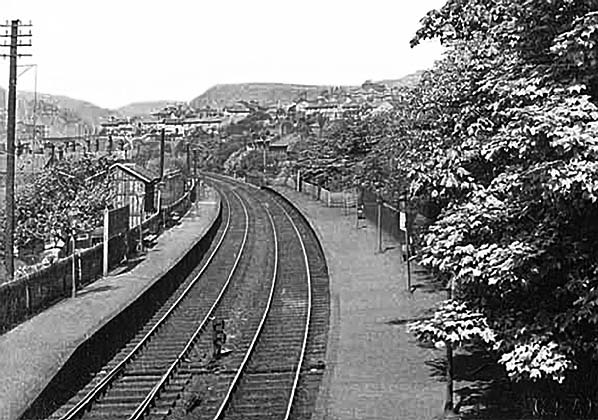



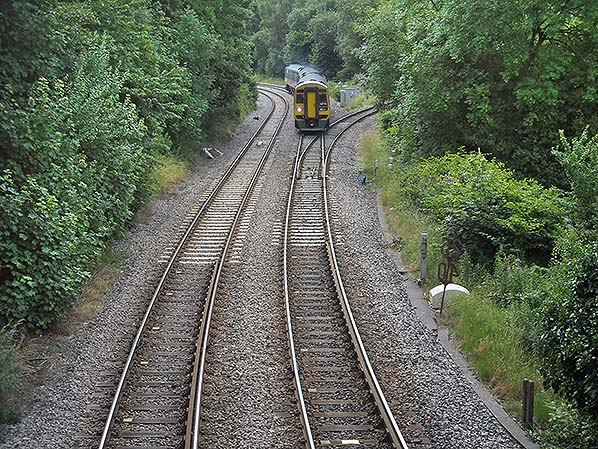
 David Taylor, a historian specialising in the Upper Calder Valley, has found the earliest mention of a stopping place at White Platts Junction (today known as Stansfield Hall Junction) in the December 1868 timetable for Todmorden – Burnley services which shows an additional daily train each way for first and second class passengers stopping at ‘Todmorden White Platts’, although not at any of the intermediate stations on the Copy Pit route, presumably a Yorkshire service. However it was some months later that the station made its first appearance in Bradshaw; this wasin August 1869, and with the name of Stansfield Hall, but no trains were shown to call. It was not until June 1871 that Bradshaw indicated that trains stopped here.
David Taylor, a historian specialising in the Upper Calder Valley, has found the earliest mention of a stopping place at White Platts Junction (today known as Stansfield Hall Junction) in the December 1868 timetable for Todmorden – Burnley services which shows an additional daily train each way for first and second class passengers stopping at ‘Todmorden White Platts’, although not at any of the intermediate stations on the Copy Pit route, presumably a Yorkshire service. However it was some months later that the station made its first appearance in Bradshaw; this wasin August 1869, and with the name of Stansfield Hall, but no trains were shown to call. It was not until June 1871 that Bradshaw indicated that trains stopped here.
 A little under a mile west of Stansfield Hall a signal box stood east of Kitson Wood Tunnel. The Kitson Wood box, a timber LYR structure, opened in 1907. According to a contemporary LYR report it contained a 16-lever LYR frame; Littleworth notes that later sources refer to an 8-lever frame, but since at least the mid 1940s only 4 levers were in use. A source of 1947 states that the box closed in winter months and that the signal arms were removed. Kitson Wood box was closed completely on 18 June 1961 and no photographs of it have been found.
A little under a mile west of Stansfield Hall a signal box stood east of Kitson Wood Tunnel. The Kitson Wood box, a timber LYR structure, opened in 1907. According to a contemporary LYR report it contained a 16-lever LYR frame; Littleworth notes that later sources refer to an 8-lever frame, but since at least the mid 1940s only 4 levers were in use. A source of 1947 states that the box closed in winter months and that the signal arms were removed. Kitson Wood box was closed completely on 18 June 1961 and no photographs of it have been found.
 Home Page
Home Page